337 Search Results for communication boards
July 9, 2013
by Robin Parker -
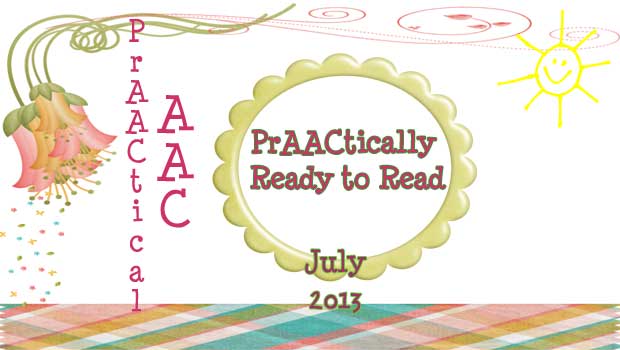
It’s summer and hot where we live (really hot!), humid (really humid)!. This weather makes it a good time for quiet, peaceful activities. Reading is high on our list. No pressure, enjoyable reading. We want ALL learners to enjoy reading. From simple single message voice output devices/apps to high-tech core language based SGDs and everywhere in between, there are lots of prAACtical opportunities for communication building, literacy learning, and just plain fun through reading. Interactive reading, reading aloud to someone, or reading to yourself can all be done in air-conditioned homes or libraries or by the pool or beach where you can cool down with a quick swim. Here are some great resources for adapted books, communication boards to go with books, and visual supports to help with reading. Find a good book, stay cool, and enjoy: New York City Department of Education: Adapted Books Baltimore City Schools- Book Specific Communication... [Read More...]
June 20, 2013
by Carole Zangari -
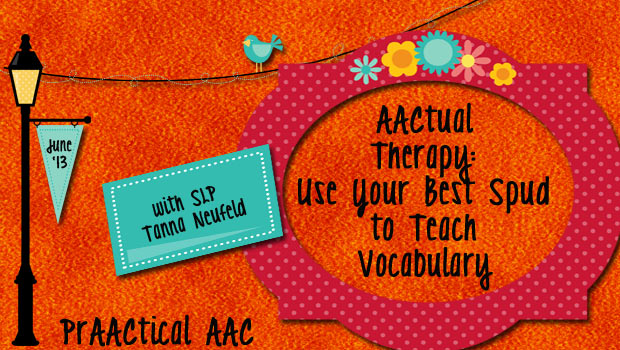
AACtual Therapist Tanna Neufeld comes through again, putting a prAACtical touch on an activity we all know and love. Tanna has generously shared both her ideas and the communication boards that she uses for this activity. You can download them in our eToolBox or go to the links at the end of this post. Tanna has great intervention tips (love her 80/20 idea!) that are prAACtical and effective for keeping kids engaged and learning. Mr. Potato Head is one of my favorite therapy tools for working with all kids, but especially beginning communicators. This awesome spud is not only a versatile toy-ripe for building, pretending, and interacting-but also a great tool for modeling vocabulary. For those little ones that you can keep engaged beyond the putting in and out of the building stage (tap into that good old fashioned, therapeutic use of self!), this toy really goes the distance. I... [Read More...]
June 5, 2013
by Robin Parker -
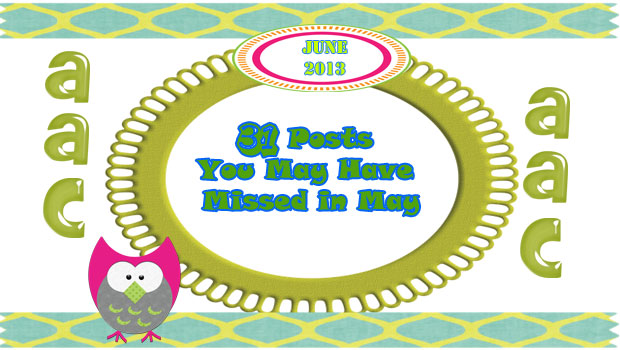
Strategy of The Month Communication Boards: Colorful Considerations Communication Boards Can Be Used For…. A Lot I Made A Communication Board: Bow What Join Together: Core & Fringe Vocabulary Fresh Look AAC in the Classroom with Joan Bruno Friendship Skills for Children Who Use AAC with Dr. Erinn Finke Top 5 Switches for People With ALS by Amy Roman AAC & Dementia with Dr. Melanie Fried Oken AAC for Children Who Have Rett Syndrome with Dr. Theresa Bartolotta AACtual TherapyHow We Do It Essential Tricks for Supporting AAC in Schools, Part 2 PrAACtical Look: AAC at Dynamic Therapy Associates by Vicki Clarke A Framework for Success Getting Started in the Exciting World of Communication & AAC with Marlene Cummings AAC Myth Buster Wrap-Up PrAActical Thinking It’s PrAACtically Better Hearing & Speech Month 30 Posts You May Have Missed for Autism Awareness Month It’s PrAACtically Mother’s Day- 5 Activities that Support... [Read More...]
May 28, 2013
by Robin Parker -
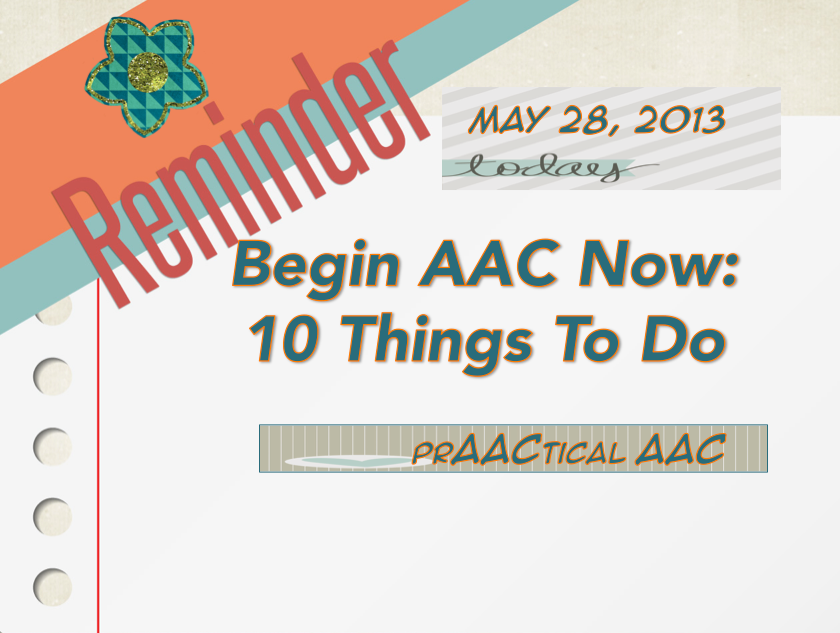
If you know someone with significant speech difficulties, BEGIN AAC NOW…. If you know someone, try something… Doing something, even if it isn’t perfect, is infinitely better than doing nothing at all…. There is no specific order for these suggestions, try what is appropriate and doable for you… A year from now you may wish you started today (K. Lamb)… So begin now at any level.. for someone, a class, a clinic, for a few… Create a Visual Language & AAC Environment: Visual Immersion Program, Meaningful Language Experiences, Importance of Using Visual Supports Speak AAC to the AAC Learner: Use Aided Language Input (ALI), Learning to Use ALI Get Assessment Information: Communication Matrix , AAC Evaluation Genie, Thoughts & Ideas, AAC Assessment Forms, Write & Implement Some AAC Goals: Goals That Matter, AAC in the IEP by Lauren Enders, PrAActical Goals Learn and Use a Core Word Approach: Core Word Communication Board Samples, About Core Words- First... [Read More...]
May 25, 2013
by Robin Parker -
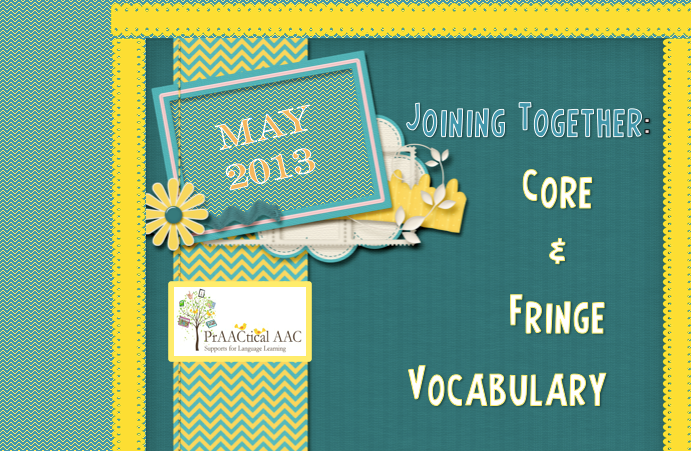
Last month we talked about Core Words, and we shared core word samples, philosophies, and resources. As we have moved into May’s Strategy of the Month, Communication Boards, we now want to share ideas about joining core and fringe words together on communication boards. Core vocabulary are those words used with high frequency and make up about 75-80% of the words we use everyday. Core vocabulary should be a main part of all AAC systems because it allows for most flexibility across most situations. With an emphasis on core words, we also use Fringe Vocabulary 20-25% of the time. Fringe vocabulary are used in a continuum of low-frequency to lower frequency situations (e.g., ‘mountain’: ‘glacier’, ‘crevasse’). Personal vocabulary can also be included under fringe vocabulary and would relate to personal words someone might need for their individual needs, interests, work, school, or even community. So, in the best communication world, AAC users would have access... [Read More...]
May 13, 2013
by Carole Zangari -
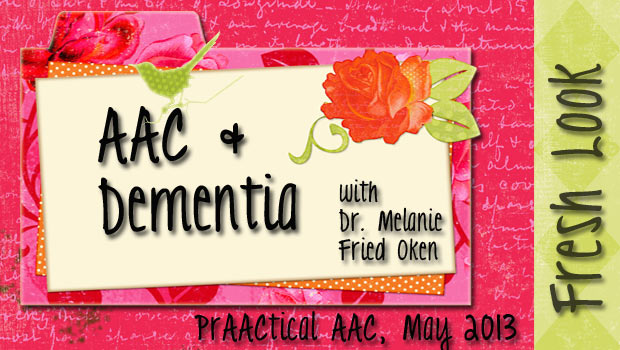
We’re thrilled to continue our Fresh Look series in celebration of Better Hearing and Speech Month (#BHSM). In this post, Dr. Melanie Fried Oken, from the Oregon Health and Science University, talks about some AAC strategies for people with dementia. I was captivated by her 2012 presentation on this topic at ISAAC 2012, and knew it was important to be able to share some of you work with you. We have much to offer these individuals with dementia, and Melanie’s post and linked resources are a great way to get started. ::::::::::::::::::::::::::::::::::::::::::::::::: Hey, what about us AAC providers who work with adults? We love reading PrAACtical AAC and can often adjust the tips, equipment recommendations, and strategies to meet our population needs. So when Carole gave me an opportunity to blog about AAC for adults with dementia, I grabbed the chance. I’d like to share with you some facts about... [Read More...]
May 7, 2013
by Carole Zangari -
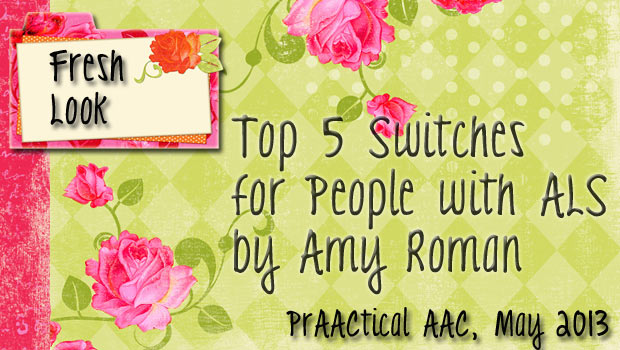
We continue our celebration of Better Hearing and Speech Month (#BHSM) with our Fresh Look series. In this post, we are delighted to share the insights of SLP Amy Roman, whose expertise in AAC supports for people with ALS is well-known. During the past 13 years, Amy has been a member of the multidisciplinary care team at San Francisco’s Forbes Norris ALS Research and Treatment Center. The AAC Program she developed at the Norris Center was awarded Program of the Year by the California Speech and Hearing Association in 2010. Through her private practice, she also provides AAC direct services and phone/skype consultations to individuals, caregivers and therapists. In addition, Amy is the Director of the Golden West ALS Association’s AAC Lending Library. She is also the author of AlphaCore© communication software available on DynaVox speech generating devices. Amy has presents workshops and at conferences on clinical and research topics in AAC.... [Read More...]
May 1, 2013
by Carole Zangari -
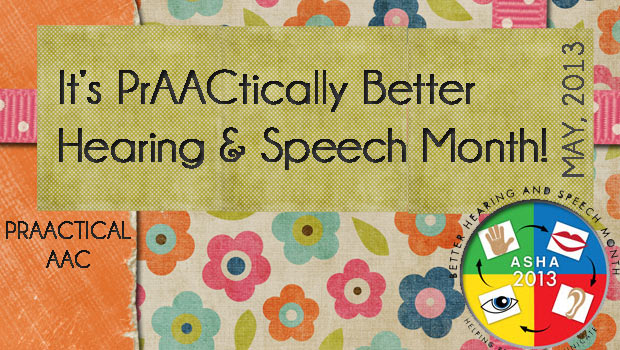
We’re celebrating ASHA’s Better Speech and Hearing Month with a series of posts for SLPs who are working with people who have significant communication difficulties and aren’t currently using AAC strategies. In these posts, we hope to give clinicians a fresh look and some prAACtical ideas about using AAC with a variety of clinical populations. We’ve invited well-respected authors, researchers, and clinicians to contribute to this series. We’re proud to kick-off a new series called Fresh Look with posts on using AAC with children and adults. Watch for posts on on a variety of topics, including: Using AAC to support people with dementia by Dr. Melanie Fried-Oken AAC in General Education with Dr. Joan Bruno Supporting the friendships of children with ASD by Dr. Erinn Fincke Providing initial AAC supports to people with ALS by Lisa Bardach Language therapy with children who use AAC by Drs. Cathy Binger and Jennifer... [Read More...]
April 29, 2013
by Carole Zangari -
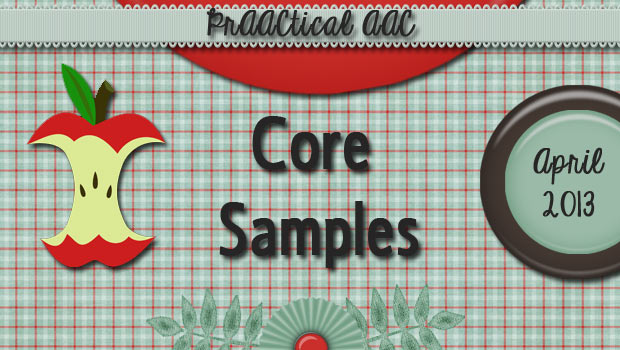
Whether we’re working on a project, cooking with new ingredients, or doing something crafty, one of the things we find most helpful is examples. Seeing how other people have approached a situation can be informative and inspiring. Making communication displays for people who use AAC is no different. Most of us appreciate the opportunity to see what our colleagues have done. We provided a number of examples of communication boards and books that are rich in core language in some of our earlier posts. Here are some of them, just in case you missed those posts. Kate Ahern’s Core Vocabulary in 3 Symbol Types (and Core Word Learning Book) via SlideShare Core language board with 20 PCS and 12 PCS by Yvonne Green via SET-BC PCS communication book (core and fringe) from the AT4All Wiki/Barbara Cannon PCS communication book pages in Boardmaker and PDF format by Polk County Public Schools... [Read More...]
April 27, 2013
by Robin Parker -
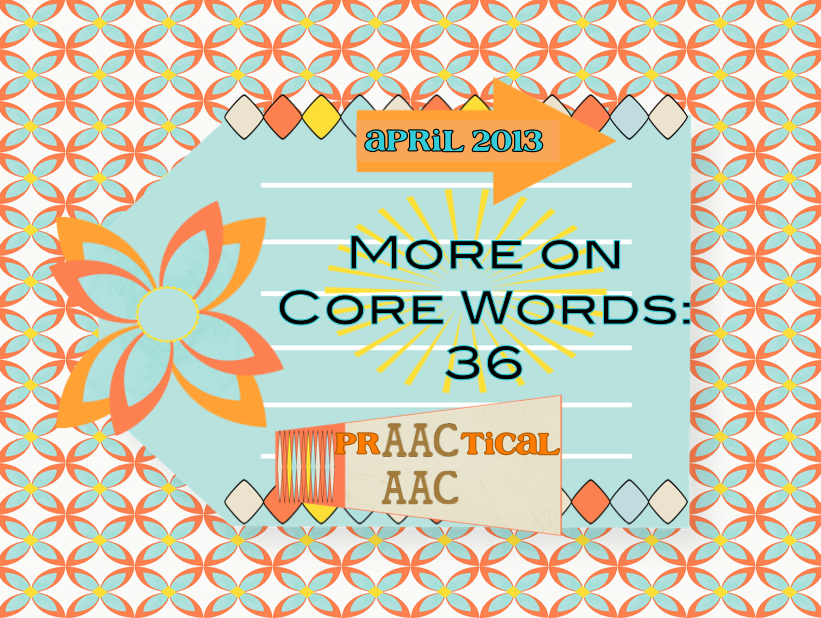
This month we have talked about core words and teaching strategies & considerations for facilitating USING core language. We have talked about aided language input, creating frequent opportunities, making connections b/w symbols and their referents, and motor planning/automaticity. As April ‘goes out’, we add graduated prompting/prompt hierarchies, and wait & signal/time delay prompts. The key to teaching AAC core word language is strategies…. Aided language input (ALI) is fairly simple to do but sometimes overlooked. However, once it becomes habit, it is hard not to do even when you are ‘just’ talking about AAC displays. There are many clinical rationales or reasons why ALI is so important. It provides a model of the language we expect from the child (or adult), and how would anyone speak a language if they never ‘heard’ it. ALI also helps by introducing new words and symbols in meaningful contexts. If we are speaking AAC throughout the day then... [Read More...]









